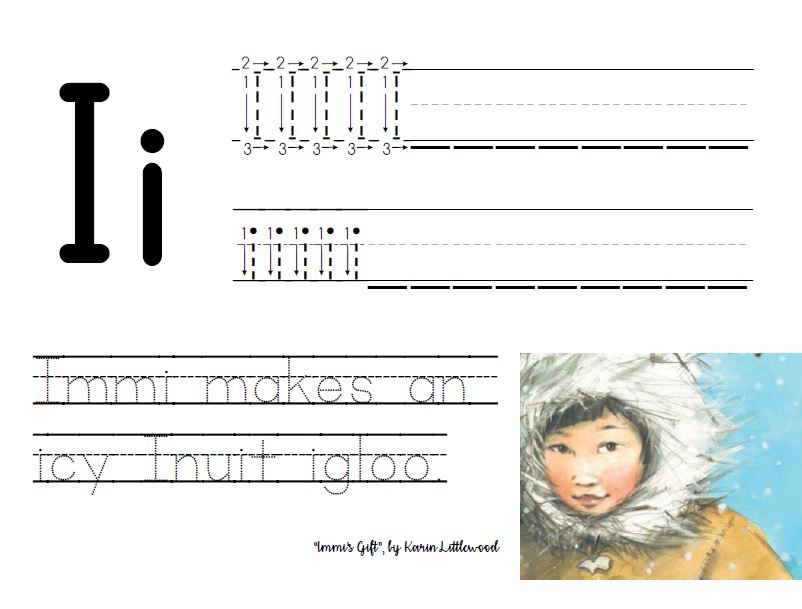Welcome! The following is the 9th in a series of 24 lesson plans, Learning the ABC’s through Literature, the 1st year. It was written especially for classroom use within a homeschool co-op, and was designed to teach the alphabet, over the course of a school year, using classic children’s literature. The books are primarily taken from the Five in a Row Curriculum by Jane Lambert, with several others added as well. The plans were designed to give just a little bit more, so it could be more usable within a classroom setting. Teacher’s questions, printables, craft ideas, classroom handouts, etc are included within all the lessons. This is geared towards a K-1st grade class. If you are interested in something similar for older children, the Learning through Literature series uses more Five-in-a-Row (FIAR) books and is a more developed concept of this same idea and also uses mostly Five in a Row books. You can find it here, Learning through Literature, the 2nd year, geared for 1st-3rd and Learning the USA through Literature – the 3rd year, geared for 2nd-4th and using books from Volume 4 of Five in a Row.
I: Immi’s Gift
What I Need:
- Immi’s Gift,
- Building an Igloo
- Globe or World Map
- Immi’s Gift Handwriting Sheet (printable version here)
If creating sugar cube igloos
- Sugar Cubes
- Paper Plates
- Tin Foil
- Glue
- Mini Cups
If creating paper “Immi’s igloos”,
- Dark blue or purple paper
- White or light blue paper, cut into rectangles
- Variety of tiny pictures–feathers, leaves, red bird, etc (you could cut these out of magazines, construction paper, or just print them out)
- Glue/Glue sticks
- Scissors (if you want them to be able to do additional cutting)
Review
By now, you may not have time to go through all the books you’ve done since the beginning of the year. If you do, great – this is a good memory / alphabetical order exercise. But in our 45-minute class, we were always running short on time, so we began to only mention the last few books we had done. Last week we talked about H is for Hedge, today, I is for …Immi
Take a moment to remind the class that there are 5 all-the-time vowels (A-E-I-O-U). and two sometimes vowels (Y and W). Vowels always make at least 2 sounds and they help us make sense out of the letters we put together. This will be old to some, and brand new to others, but it is good to at least mention it.
Introduce the Story
What continents have we visited so far in our books? (North America, Africa, Europe)
Take a moment to review your favorite continent song. I listed a couple in our Galimoto Lesson, if you need one
(Find the Arctic on the globe, discuss the differences between the Arctic (North Pole) and the Antarctic (South Pole) (Arctic is only solid ice, no land underneath. Habited by polar bears, walrus, arctic hares, and some (few) people / Antarctica is a giant frozen landmass It is a huge island at the bottom of the world. No one lives there except a handful of researchers and a LOT of penguins. (and other animals, of course). Much colder.)
Introduce Inuit People.
Immi was an Inuit Indian. She goes ice fishing, makes an igloo, which is the Inuit word for “home”. She is a member of the Inuit tribe.
Who were the Inuits? (pronounced In-Yoo-it)
Read the Story
You will want a globe on hand while you are reading this story. This is a great time to mention the location of the equator, and the fact that both the poles are very cold, and the equator is very HOT.
Though the author doesn’t tell us where the ‘gifts’ are arriving from, you can tell by the pictures that this is a tropical location. Use the globe to find tropical islands south of the Alaskan / North American spot where the Inuit’s live to discuss where the bone/flower could have come from.
It is okay to note that this is NOT a true story, and it would be pretty impossible for this to happen 🙂 … but still, a fun teachable lesson on the Inuits, the North and South Poles, and the Climate around the Globe.
Inuit Vocab:
Talk about a great book for the letter, I! Here is some neat Inuit vocab to introduce. I don’t think you need to introduce this with the story. But if you have time, these are some fun words in the Inuit language, one of which they almost surely already know (igloo).
- Inuit: the people
- Inuk: one Inuit
- Inuksuk – a pile of stones to keep someone from getting lost
- Igloo – home
Click here to return to the Learning the ABC’s through Literature complete booklist and see the general instructions for each lesson.






